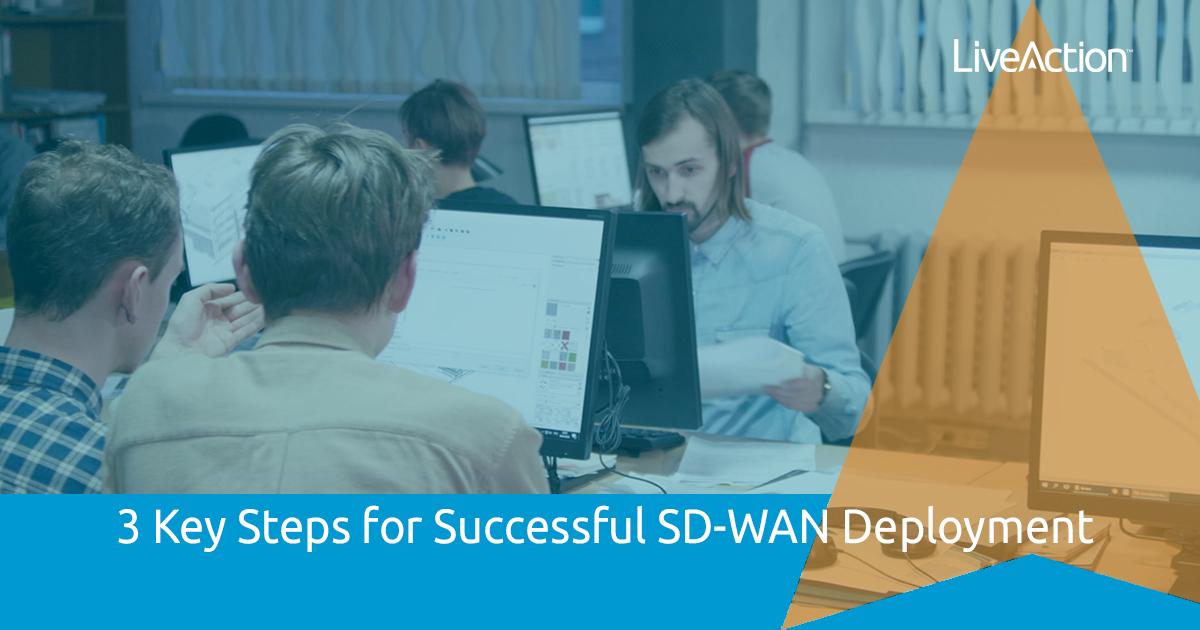
 Last month Brooks wrote about how LiveAction helps future-proof SD–WAN adoption. This week, I’d like to dive into the major steps involved in planning and deploying an SD-WAN into your existing environment, the challenges associated with each, and how LiveAction can help you navigate them.
Last month Brooks wrote about how LiveAction helps future-proof SD–WAN adoption. This week, I’d like to dive into the major steps involved in planning and deploying an SD-WAN into your existing environment, the challenges associated with each, and how LiveAction can help you navigate them.
By now, you’ve probably seen the growth stats, but to reiterate, Gartner forecasts that by the end of 2021, more than 65 percent of enterprises will have deployed SD-WAN technology. But, planning, deploying and operationalizing SD-WANs can be complex and time-consuming, especially if you’re not fully aware of the potential pitfalls along the way.
Changing from an on-premises router architecture to a cloud-based controller architecture requires a tremendous amount of awareness around the current state of the network to ensure effective planning; what we typically call “Day 0” in the network lifecycle. There’s an endless list of questions to consider upfront. What sites, data centers, public cloud workloads, service providers, SaaS, applications, and users will be involved and how will they be impacted? Will you use physical or virtual appliances (or both), on-premises equipment or SaaS (or managed services)? Are you going for a brownfield or greenfield deployment? What selection criteria will you use to navigate a field of more than 40 vendors offering SD-WAN solutions? How will your functionality, scalability and complexity requirements impact the options available? Will you or the vendor manage it? Will it use legacy infrastructure, require additional staff?So, with a laundry list of questions that need answers, where do you begin?
To date, we’ve helped more than 200 customers rollout SD-WANs and we approach the process in three standard phases: baseline planning (Day 0), deployment verification (Day 1), and ongoing operational insight (Day 2). Here’s how it works:Day 0 – Baseline Your Current Performance – In this initial phase, you should inventory and evaluate all of your network devices and how they support the business requirements at the various sites. Have you considered how this new initiative will interface with your existing infrastructure? Whether it’s a smaller branch or a larger campus, you need to have a firm grasp on how those connections will happen, especially if you already have legacy infrastructure that can support deployed SD-WAN technology (such as Cisco IWAN). In terms of transport, there’s typically existing service providers and internet access. Can you reduce the investment in MPLS bandwidth? You’ll need to determine if more service providers will need to be added or if you’ll use MPLS to save money. There’s also a lot of concern about public cloud as organizations use AWS, Microsoft Azure, or Google Cloud. How will those be incorporated into your deployment?
How LiveNX helps: Our customers use LiveNX to complete an initial network assessment before SD-WAN is deployed. This allows them to understand the existing capabilities of their WAN, what the baselines are, what applications are running, the number of sites, service providers and their SLAs, and more. Essentially, Day 0 with LiveNX is all about establishing a complete picture so teams can understand how to optimize the infrastructure for the business.
Day 1 – Validate That the Deployment Performs As-designed – Once an SD-WAN vendor is selected, and planning and design has been completed, a subset of sites are rolled out. This requires planning around deployment phases and scaling. More importantly, during this portion of the process, you’ll need to identify how you’ll handle cutovers and what services will run through the new SD-WAN. And, as you bring on new transport, it’ll be critical to know exactly what transitions need to happen to support that integration.
How LiveNX helps: During deployment, LiveNX gives teams the ability to verify the policies that have been created for path routing across the WAN and monitor for application turn-up. Providing this level of assurance means real-time visibility into the new SD-WAN and surrounding network (by pulling from multiple data sources).
Day 2 – Manage and Optimize Network Performance – A lot of vendors offer basic SD-WAN monitoring capabilities, but most companies need holistic visibility of both existing and newly deployed network infrastructure. They’re likely to maintain or roll out SD-WAN over time, meaning they’re looking for additional tools that can extend their visibility. The technology doesn’t live within a vacuum. It connects to other parts of the network. Understanding and seeing how that integration is happening, what impact it’s having, and being able to properly manage it with real-time visibility is central for both maintaining performance levels and quickly troubleshooting issues.
How LiveNX helps: Day-to-day monitoring and alerting is a vital part of understanding the ongoing operational impact of any SD-WAN. LiveNX provides the visibility needed to preserve critical performance levels as deployments are scaled, optimize policies and troubleshoot problems that could lead to finger-pointing. Through proactive alerts, historical traffic analysis, and ongoing capacity planning, LiveNX dramatically simplifies SD-WAN management.To support SD-WAN without compromising user experience or straining resources, IT leaders need clear migration paths that de-risk their adoption. Have questions about the best way to approach a new SD-WAN initiative? LiveAction has helped hundreds of customers find the answers and successfully navigate their networks. To learn more about how LiveAction helps with SD-WAN deployment, check out my presentation with John Smith at Tech Field Day Extra from Cisco Live 2018, or dive deeper into how LiveNX can help with Cisco SD-WAN.



